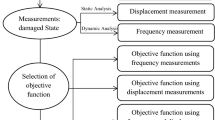Abstract
This paper investigates the performance of a nonlinear damage detection method using sensitivity enhancing control (SEC). Damage nonlinearity due to the cyclic behavior of crack breathing could provide valuable evidence of structural damage without information of the structure’s original healthy condition. Not having such information is considered a major challenge in vibration-based damage detection. In this study, two different categories of damage detection methods are investigated: frequency and time-domain techniques focusing on the benefit of SEC for breathing-type nonlinear damage in a structure. Numerical simulations using a cantilevered beam and spring-mass-damper system demonstrated that the level of nonlinear dynamic behavior heavily depends on the closed-loop pole placement through feedback control. According to SEC theory, the characteristic of the feedback gain defines the sensitivity of modal frequency to the change of stiffness or mass of the system. The sensitivity enhancement by properly designed closedloop pole location more visually clarifies the evidence of crack nonlinearity than the open-loop case where no sensitivity is enhanced. A damage detection filter that uses time series data could directly benefit from implementing SEC. The amplitude of damage-evident error signal of the closed-loop case significantly increases more than that of the open-loop case if feedback control or SEC properly modifies the dynamics of the system.
Similar content being viewed by others
References
Chati, M., Rand, R. and Mukherjee, S., 1997, “Modal Analysis of a Cracked Beam,”Journal of Sound and Vibration, Vol. 207, No. 2, pp. 249–270.
Cheng, S. M., Wu, X. J., Wallace, W. and Swamidas, A. S. J., 1999, “Vibrational Response of a Beam with a Breathing Crack,”Journal of Sound and Vibration, Vol. 225, No. 1, pp. 201–208.
Chondros, T. G., Dimarogonas, A. D. and Yao, J., 2001, “Vibration of a Beam with a Breathing Crack,”Journal of Sound and Vibration, Vol. 239, No. 1, pp. 57–67.
Douka, E. and Hadjileontiadis, L. J., 2005,“Timefrequency Analysis of the Free Vibration Response of a Beam with a Breathing Crack,”NDT & E International, Vol. 38, No. 1, pp. 3–10.
Kisa, M. and Brandon, J., 2000, “The Effects of Closure of Cracks on the Dynamics of a Cracked Cantilever Beam,”Journal of Sound and Vibration, Vol. 238, No. 1, pp. 1–18.
Koh, B. H. and Ray, L. R., 2004, “Feedback Controller Design for Sensitivity-based Damage Localization,”Journal of Sound and Vibration, Vol. 273, No. 1–2, pp. 317–335.
Koh, B. H., Dharap, P., Nagarajaiah, S. and Phan, M. Q., 2005a,“Real-Time Structural Damage Monitoring by Input Error Function,”AIAA Journal, Vol. 43, No. 8, pp. 1808–1814.
Koh, B. H., Li, Z., Dharap, P., Nagarajaiah, S. and Phan, M. Q., 2005b, “Actuator Failure Detection using Interaction Matrix Formulation,”Journal of Guidance, Control, and Dynamics, Vol. 28, No. 5, pp. 895–901.
Kranock, S. J., 2000, “Real-time Structural Damage Detection Using Model-Based Observers,”Ph.D. Dissertation, Department of Aerospace Engineering Science, University of Colorado, Boulder, CO, USA.
Leonard, F., Lanteigne, S., Lalonde, J. and Turcotte, Y., 2001, “Free-vibration Behavior of a Cracked Cantilever Beam and Crack Detection,”Mechanical Systems and Signal Processing, Vol. 15, No. 3, pp. 529–548.
Liberatore, S., Speyer, J. L. and Hsu, A. C., 2006, “Application of a Fault Detection Filter to Structural Health Monitoring,”Automatica, Vol. 42, No. 7, pp. 1199–1209.
Palacz, M. and Krawczuk, M., 2002, “Vibration Parameters for Damage Detection in Structures,”Journal of Sound and Vibration, Vol. 249, No. 5, pp. 999–1010.
Pugno, N., Surace, C. and Ruotolo, R., 2000, “Evaluation of the Non-linear Dynamic Response to Harmonic Excitation of a Beam with Several Breathing Cracks,”Journal of Sound and Vibration, Vol. 235, No. 5, pp. 749–762.
Ray, L. R. and Tian, L., 1999, “Damage Detection in Smart Structure Through Sensitivity Enhancing Feedback Control,”Journal of Sound and Vibration, Vol. 227, No. 5, pp. 987–1002.
Ray, L. R., Koh, B. H. and Tian, L., 2000, “Damage Detection and Vibration Control in Smart Plates: Towards Multifunctional Smart Structures,”Journal of Intelligent Material Systems and Structures, Vol. 11, pp. 725–739.
Seibold, S. and Weinert, K., 1996, “A Time Domain Method for the Localization of Cracks in Rotors,”Journal of Sound and Vibration, Vol. 195, No. 1, pp. 57–73.
Sohn, H., Farrar, C. R., Hemez, F. M., Shunk, D. D., Stinemates, D. W. and Nadler, B. R., 2003, “A review of Structural Health Monitoring Literature: 1996–2001,”Technical Reports LA-13976-MS, Los Alamos National Laboratory.
Tsyfansky, S. L. and Beresnevich, V. I., 2000, “Non-linear Vibration Method for Detection of Fatigue Cracks in Aircraft Wings,”Journal of Sound and Vibration, Vol. 236, No. 1, pp. 49–60.
Xu, H. and Mehrmann, V., 1998, “Choosing Poles So That the Single-input Pole Placement Problem is Well Conditioned,”SIAM Journal on Matrix Analysis and Applications, Vol. 19, pp. 664–681.
Author information
Authors and Affiliations
Corresponding author
Rights and permissions
About this article
Cite this article
Koh, BH. The influence of enhanced closed-loop sensitivity towards breathing-type structural damage. J Mech Sci Technol 21, 997–1007 (2007). https://doi.org/10.1007/BF03027649
Received:
Revised:
Accepted:
Issue Date:
DOI: https://doi.org/10.1007/BF03027649




